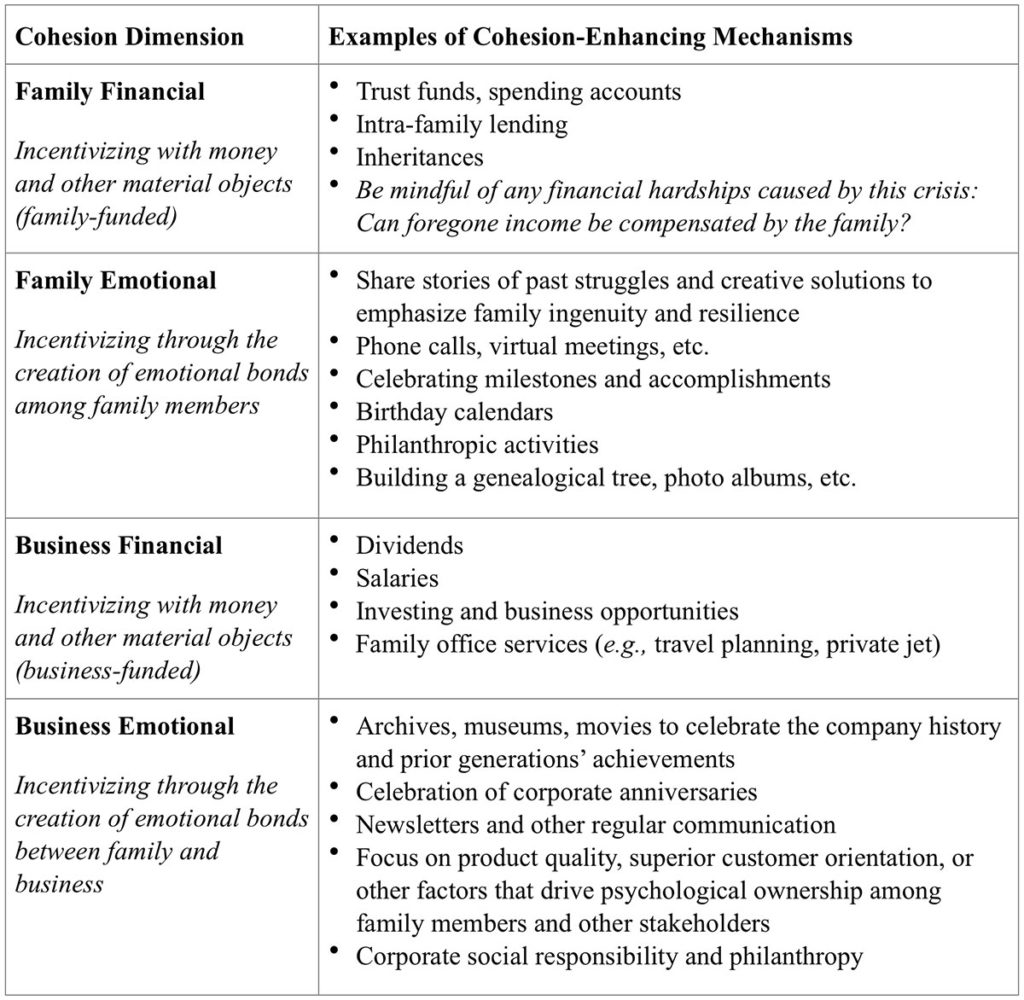
View this edition in our enhanced digital edition format with supporting visual insight and information.
Thank you to research report authors Claudia Astrachan and Torsten Pieper and FFI Fellow Andrew Keyt for this timely article on family cohesion, explaining how cohesion can drive family enterprise resilience to cope with disruption such as a worldwide pandemic. This is the third in our series of commentaries on the 2086 Society sponsored research on “Professionalizing the Business Family: The Five Pillars of Competent, Committed and Sustainable Ownership.”
In recent years, many organizations have dedicated considerable resources to adequately prepare for whatever disruptions the digital revolution might bring to their industries. The disruption we are currently facing—the COVID-19 pandemic—is much less novel, or technologically complex, but has mostly been unforeseeable in its momentousness. As companies scramble to adjust to the daily-changing reality and the lack of predictability the virus has brought to our nations, we’d like to provide family business leaders with actionable insights to effectively navigate the current challenges.
The current COVID-19 pandemic is a striking example of the drastic impact unanticipated events can have on society and on our interconnected global economy. Many companies will likely experience severe and possibly insurmountable disruptions in the months to come. In spite of the dire outlook, our experience, in conjunction with empirical and anecdotal evidence, suggests that family-owned companies are uniquely equipped to deal with the forthcoming challenges—if the family is aligned and cognizant of the group’s strengths, as well as their limitations. In this article, we focus on one dimension we have identified as particularly prevalent in successful, professional, and long-lived business families, and which we found to be a key driver of resilience: family cohesion.
While it may seem as if crises and disruptions have been growing exponentially in recent years, ‘black swan’ events have challenged humankind for many generations. Throughout these times, families have demonstrated incredible resilience and strength. This strength comes from cohesion—a sort of psychological glue that effectively ties members to one another and to the group—that is particular to families and rarely matched by other types of groups. Business family cohesion permeates the organization and often transcends it, reaching their customers, suppliers, and the communities they serve. Such cohesion creates benefits for all parties involved by enhancing trust and harmony, boosting morale, and lowering transaction costs, thus enabling an effective and sustainable family business system.
But what fosters cohesion? Cohesion is multi-faceted by nature, insofar as individuals are motivated differently to remain a member of any group. Some family members may be primarily driven by financial rewards, others by emotional incentives; some seek connection first and foremost through the family, while others relate primarily through the business. Effective and professional business families understand that they need to simultaneously offer their family members a broad range of cohesion mechanisms to secure their commitment. Table 1 below summarizes the four dimensions of family cohesion and provides concrete examples of cohesion-enhancing mechanisms for each dimension.
Let’s take a closer look at emotional cohesion, since this dimension (both on the family and business level) is often overlooked. Stories of important challenges of the past that the family or the business successfully mastered are a powerful tool to create emotional bonds among family members, and between the family and the business. This is particularly true now, when social distancing prevents us from being physically close and when families might struggle with maintaining a feeling of connectedness, or when they lack a positive outlook for the future. For example, crafting a genealogical tree of the family—which can be developed and shared electronically (think: Skype, Zoom, Email) with family near and far—fosters identification and a sense of belonging. Remembering past successes, the hardship the previous generations endured, sacrifices they made, and creative solutions they engineered to overcome challenges may provide orientation and impetus for action. And lastly, remembering that relationship quality is directly related to how often, how deeply, and how long we talk might encourage us to pick up the phone or schedule a virtual meeting to reach out and show sympathy and care.

Table 1: Cohesion mechanisms and examples (Pieper & Astrachan, 2009; Binz Astrachan, Waldkirch, Michiels, Pieper, & Bernhard, 2020)
Most business families (historically) favor certain types of cohesion; while some lean toward financial incentives, others are inclined toward emotional bonding. Ultimately, achieving balance among all four dimensions is key. However, without a solid foundation of broadly shared values and a superordinate goal that unifies and excites the family across branches and generations, family members’ commitment to both the family and the business tends to be short-lived.
So how should business families go about strengthening cohesion? Cohesion can be built along any dimension, in parallel or simultaneously. However, families need to be cognizant of their readiness for this process. What does this mean? Business families have different levels of maturity—this means, for example, that their ability to communicate or deal with conflict effectively, or the level of ownership competence within the ownership group, vastly differs. If a family that currently lacks cohesion puts in place cohesion-enhancing mechanisms that require a high level of family member trust and commitment (e.g., intra-family lending that is tied to certain requirements or conditions), these efforts may cause the family more harm than good. We call this a lack of family-practice fit (Binz Astrachan, Astrachan, Kotlar, & Michiels, 2020). A detailed assessment of the family’s ability to deal with the consequences of any policy, structure, or process put in place is essential in the design and implementation of said measure. For example, a family that has high exchange values might choose financially-oriented mechanisms in family and business. When these are securely in place, greater investment can be made in the emotionally oriented cohesion mechanisms. It is a good idea to be moving on all mechanisms, but focus should be placed in areas of greatest likelihood of success first. Much care should be given to this process; continuously engaging family members and making sure that they feel heard is crucial, as is aspiring to a high level of transparency. If family members feel involved in the process, the likelihood of acceptance of the outcome increases significantly.
Building family cohesion is a long-term project and given the exponential growth that most business families experience, the project is constantly evolving. Cohesion is an essential characteristic of successful, professional business families. Those families tend to approach the subject systematically and purposefully, dedicating significant resources to the development and protection of family cohesion, e.g., by appointing a trusted family member (or even by forming a dedicated committee) to be in charge of these efforts.
Particularly in times of disruption, as we are currently experiencing, cohesion is a key driver of family unity. Cohesion facilitates quick decision-making, allowing the family to remain active participants, which is particularly important when things are constantly evolving. Talking to several business families with a proven track record in mastering crises in the past few weeks, we have gathered some best practices that we deem beneficial and applicable for most.
Actions for your clients to take in the family realm:
- Look to their values and past experiences for guidance: What other challenges have they overcome? Advise your clients to tell those stories to remind others that together, they will work our way through this.
- Lean into their strengths: They have resilience and the ability to recover from challenges.
- Lead with intention: Respond rather than react. Responding will require your clients to slow themselves down and work with their family and leadership team toward common goals.
Actions for your clients to take in the business realm:
- Staying on Top: Set up a “war room” with regular senior leadership team meetings (virtually or in person) for morning and evening check-ins.
- Preparedness: Test IT infrastructure to make sure it can handle more people working from home. Develop employee communication plans in case a location has an infection, or a community has a lockdown. Advise your clients to communicate their policy regarding health status and compensation. This includes what to do if employees feel sick or have contact with people who are sick (including family), PTO, triggering events for furloughs, etc.
- Foresight: Develop plans and required actions for if the crisis lasts 1 month, 3 months, 6 months, and 1 year or more. Advise your client to contact their commercial bank/relationship manager and share their planned response to anticipated slowing of sales, production or service challenges, and supply chain disruptions.
Actions for you to take:
- Mindfulness: You live with three spheres: What you can control, what you can influence, and what is beyond your control and influence. Focus on what is within your control and what you can influence.
- Focus: Decide which wolf you will feed. One wolf is the 24-hour news noise which adds to your anxiety. The other wolf is your support system—sleep, regular meals, prayer, meditation, humor, and your plan for the day. Feed the one that will support the work you need to do.
- Self-Regulation: Anxiety is contagious. No matter who you are, you can help contain and manage anxiety with your own behavior.
It was John Boyd, the maverick fighter pilot and strategy guru, who said that “whoever can handle the quickest rate of change is the one who survives.” Cohesion and its sustaining mechanisms are key to providing business families with the capacity to change quickly and to maintain orientation in times of chaos and disruption. Building cohesion can take many forms, and despite all the hardship that the current circumstances bring, perhaps they also contain the opportunity to band together and to develop a productive, committed, and fulfilled family and business for the long-term.
References
Binz Astrachan, C., Waldkirch, M., Michiels, A., Pieper, T., & Bernhard, F. (2020). Professionalizing the Business Family: The Five Pillars of Competent, Committed and Sustainable Ownership. FFI Research Report. Available at: https://digital.ffi.org/pdf/ffi_professionalizing_the_business_family_v5.pdf
Binz Astrachan, C., Astrachan, J., Kotlar, J. & Michiels, A. (2020). Addressing the Theory-Practice Divide in Family Business Research: The Case of Shareholder Agreements. To be presented at IFERA Conference, June 24-27, 2020, Santander, Spain.
Pieper, T. M., & Astrachan, J. H. (2008). Mechanisms to assure family business cohesion: Guidelines for family business leaders and their families. Kennesaw, GA: Cox Family Enterprise Center.
The 2086 Society is now considering topics for the 2020 applied research initiative and subsequent grant. If you have a good idea for consideration, please submit it to ffi@ffi.org Thank you.
About the Contributors

Dr. Claudia Binz Astrachan is a researcher and lecturer at Lucerne University of Applied Sciences and Arts (HSLU). In her role as the head of the Family & Business program she has been working closely with Swiss family businesses for the last decade. In addition to her role at HSLU, she acts as the head of the governance practice at Keyt Consulting, a US-based family business consulting company.

Andrew Keyt is the Executive Director at the Loyola University Chicago Family Business Center and is an internationally known business strategist and succession planning expert for family-owned businesses. Keyt is also President and Founder of Keyt Consulting, a private firm that assists family enterprises with succession and strategic planning, dealing with family conflict and communication, and executing emergency management transitions.

Torsten M. Pieper is Associate Professor of Management in the Belk College of Business at The University of North Carolina at Charlotte. Dr. Pieper is President of the International Family Enterprise Research Academy (IFERA), the largest network association of family business researchers in the world, and Editor-in-Chief of the Elsevier title Journal of Family Business Strategy (JFBS). He frequently works with business families and their advisors on varied topics such as strategic planning, next generation education, and maintaining family cohesion in diverse industries and geographic contexts.

View this edition in our enhanced digital edition format with supporting visual insight and information.





